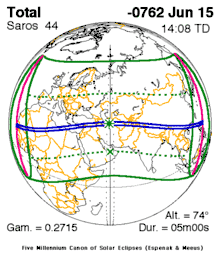Assyrian eclipse
The Assyrian eclipse, also known as the Bur-Sagale eclipse, is a solar eclipse recorded in Assyrian eponym lists, most likely dating the ninth year of the reign of king Ashur-dan III. The eclipse is identified with the one that occurred on 15 June 763 BC (proleptic Julian calendar).

The entry is short and reads:
- "[year of] Bur-Sagale of Guzana. Revolt in the city of Assur. In the month Simanu an eclipse of the sun took place."
The phrase used — shamash ("the sun") akallu ("bent", "twisted", "crooked", "distorted", "obscured") — has been interpreted as a reference to a solar eclipse since the first decipherment of cuneiform in the mid 19th century. The name Bur-Sagale (also rendered Bur-Saggile, Pur-Sagale or Par-Sagale) is the name of the limmu official in the eponymous year.
In 1867, Henry Rawlinson identified near-total eclipse of 15 June 763 BC as the most likely candidate (the month Simanu corresponding to the May/June lunation),[1] visible in northern Assyria just before noon. This date has been widely accepted ever since; the identification is also substantiated by other astronomical observations from the same period.[2]
This record is one of the crucial pieces of evidence providing an absolute chronology of the Ancient Near East for the Assyrian period.
See also
References
- Rawlinson, Henry Creswicke, "The Assyrian Canon Verified by the Record of a Solar Eclipse, B.C. 763", The Athenaeum: Journal of Literature, Science and the Fine Arts, nr. 2064, 660-661 [18 May 1867].
- Hermann Hunger, "Zur Datierung der neuassyrischen Eponymenliste," Altorientalische Forschungen, Vol. 35:2, 2008, pp. 323-325. An English translation is available on the web:
External links
- Path map of eclipses 780 BCE - 761 BCE (NASA) - Includes total eclipse of June 15, 763 BC (labeled -0762 June 15)
- Path map of eclipses 800 BCE - 781 BCE (NASA) - Includes annular eclipse of June 24, 791 BC (labeled -0790 June 24)
- Five Millennium (-1999 to +3000) Canon of Solar Eclipses Database – maps the visibility of the total solar eclipse of June 15, 763 BC.
- Five Millennium (-1999 to +3000) Canon of Solar Eclipses Database – maps the visibility of the annular solar eclipse of June 24, 791 BC.
.jpg)
